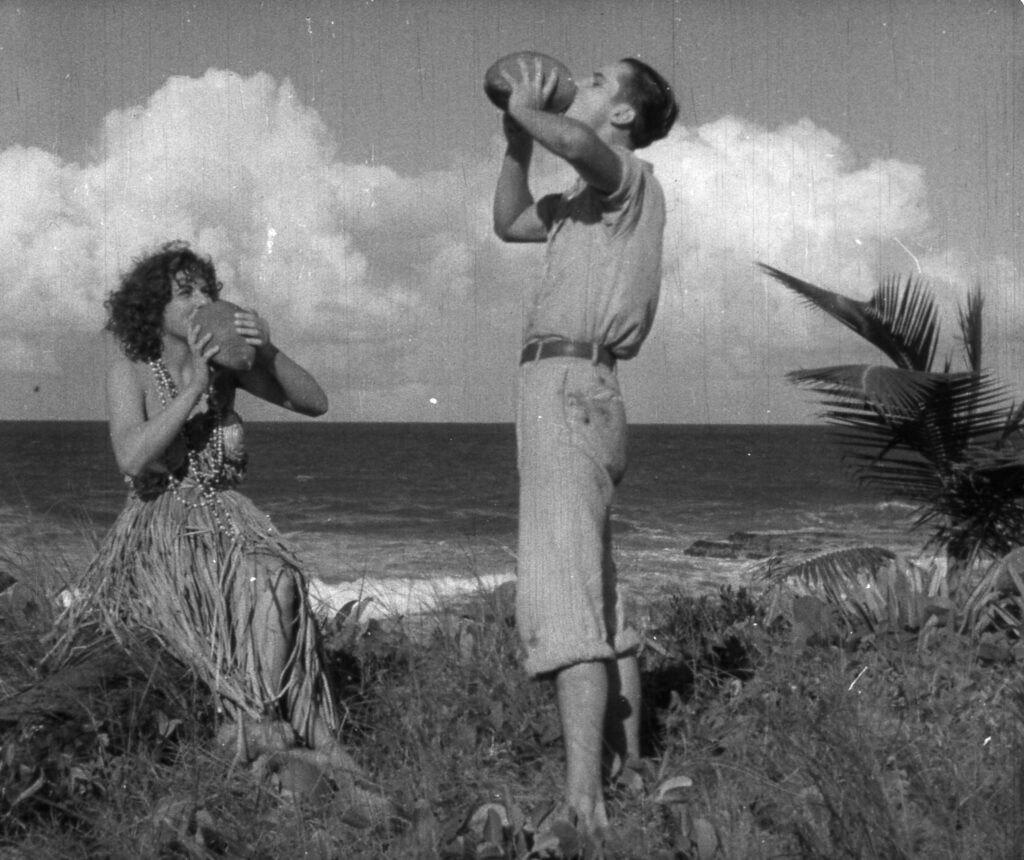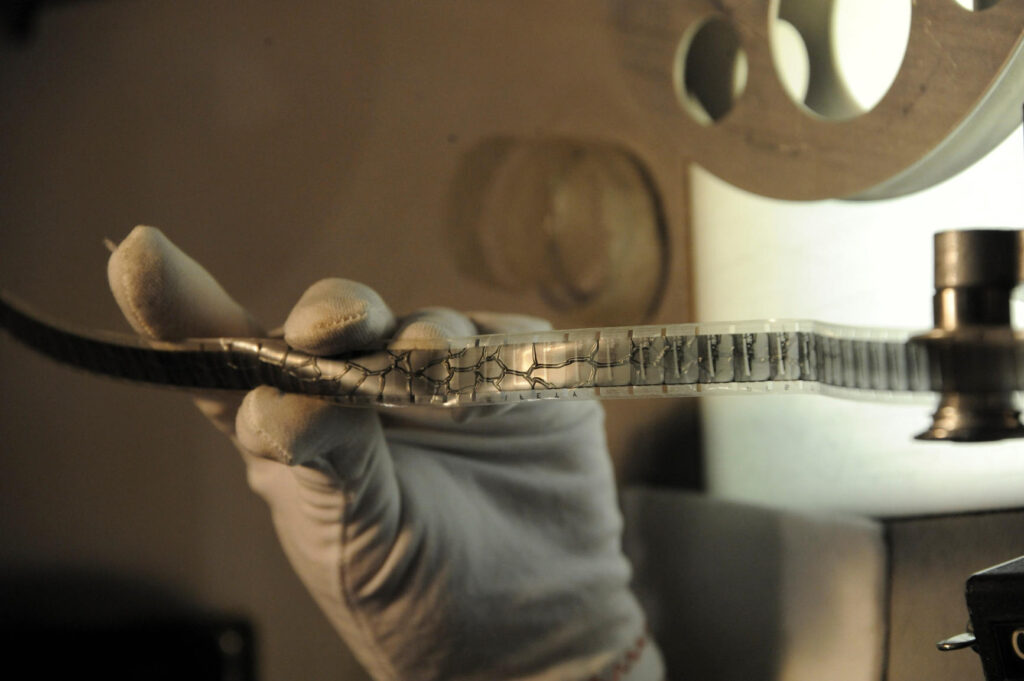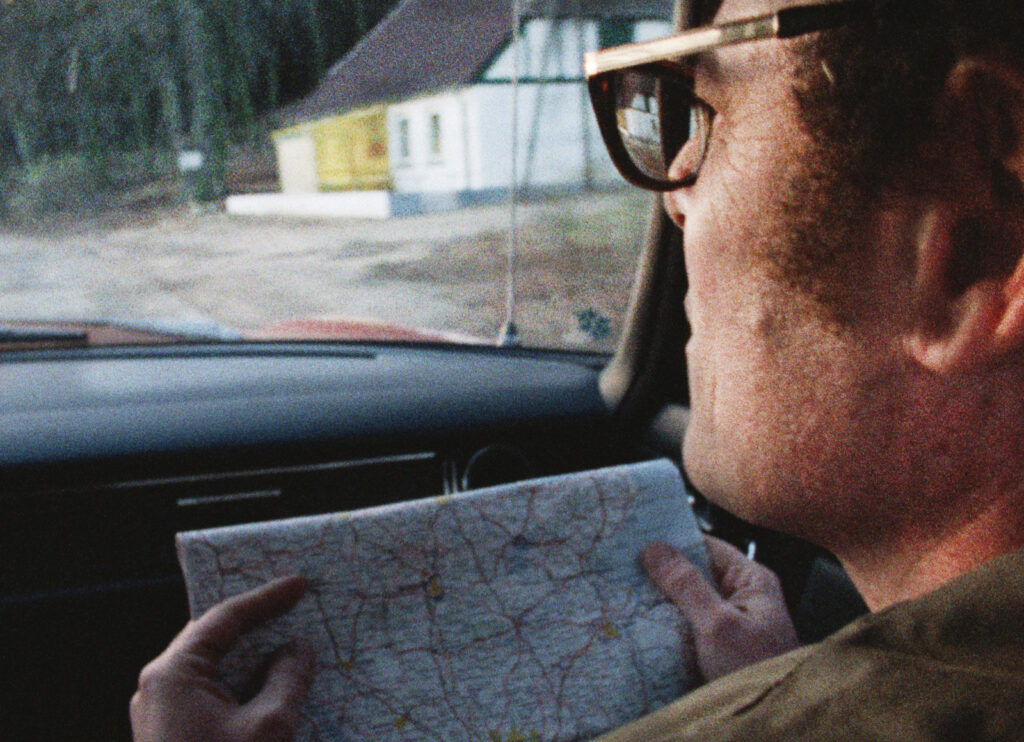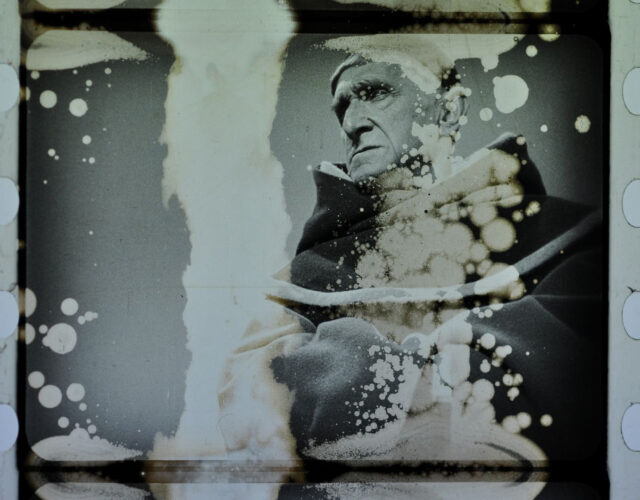Juan Emilio Viguié caught the movie bug early, just as the technology for creating motion pictures was developing. Born in 1891, he was barely out of his teens when he bought his own camera and began shooting newsreels about life in his hometown of Ponce, Puerto Rico. He eventually made his way to Hollywood, where he worked for Universal and Paramount, then returned home to set up his own film studio.
Viguié found success and even a degree of international fame when both Fox and MGM bought distribution rights to several of his shorts, including one about Charles Lindbergh’s 1928 visit to Puerto Rico. Eventually, Viguié would go on to produce Puerto Rico’s first “talkie” feature, Romance Tropical, an 80-minute love story set on a mysterious island. Released in 1934, it enjoyed a brief but well-received run in Puerto Rico, then fell out of circulation.
The film’s original negatives also disappeared; it’s anyone’s guess whether they were tossed out or destroyed by fire—an alarmingly common fate for early films (the Library of Congress estimates that 75% of the silent films and talkies made before 1929 have been lost forever). Like Romance Tropical, most of these films today have no name recognition, but titles featuring Lon Chaney, Clara Bow, and other early screen stars have also gone missing. So have a 1917 version of Cleopatra and the first screen adaptation of The Great Gatsby, released in 1926.
When an older film does survive, it’s likely to be in the form of the prints that were sent to theaters screening the movies. The problem is that “basically everything” can go wrong with these prints, according to Jan-Christopher Horak, director of UCLA’s Film and Television Archive.

Actors Raquel Canino and Jorge Rodriguez in a still from Juan Viguié’s Romance Tropical (1934).
“Start with the sheer wear and tear from being run on a projector,” he begins. “You’ve got metal running against a plastic type of material. You could show it 50 times and you wouldn’t see a lot of damage, but the old ones were shown 300 or 400 times per print as they moved from theater to theater. So the prints broke, they got scratched, their sprockets got damaged. Or, the film would go overseas and would be shortened or censored and scenes might be totally lost. I’ve heard stories about projectionists who would cut out their favorite scene, maybe as souvenirs.”
And, of course, there’s the volatile and fragile nature of the film stock itself.
Archivists such as Horak have devoted their careers to restoring and preserving what does survive of film history. In an industry perceived as being primarily concerned with blockbusters, shoot-’em-ups, and sequels, their job can involve exhaustive detective work to find missing footage and the investment of hundreds of thousands of dollars to support the kind of repair and cleaning more typically associated with tending to a Vermeer or a Van Gogh. When it all works out, it can be a “minor miracle,” as Horak puts it.
“From a cultural standpoint, these projects mean regaining a part of history, rediscovering a part of human expression,” says Margaret Bodde, executive director of the Film Foundation, a nonprofit organization that matches film-restoration projects (proposed by member archives) with funding sources. “It’s like losing the draft of a novel and there’s no other copy of it. In the case of films that people know about and have seen and then are gone, there’s no way to convey the importance of them to a younger generation.”
When we think of film restoration, we might imagine the fresh versions of Hollywood classics, such as Citizen Kane and The Sound of Music. But saving the artifacts of world cinema is equally critical, according to Bodde. “In regions without a large film industry, it’s exponential how much more important each motion picture becomes,” she says. “In those cases, there may only be a handful of films to represent that cultural patrimony.” The foundation’s World Cinema Project has so far restored 32 films from countries in Africa, Asia, Eastern Europe, Central America, South America, and the Middle East that have no archival system. These movies represent a nation’s “collective memory,” Brazilian filmmaker Walter Salles has said. They offer a “very powerful tool . . . to understand where we come from, who we are, and where we’re going to.”
That’s why when Horak stumbled on Romance Tropical in 2016, as he searched his database for films to include in a program on Latin American cinema, he didn’t just shrug his shoulders and move on. Its generic title may have sounded like a travelogue, but an internet search indicated the film was thought lost. To confirm his suspicions that what he had might be a print of that missing movie, he tracked down an exhibition history and hunted out movie reviews. After he contacted the Institute of Puerto Rican Culture with his findings, a representative of the agency traveled to Los Angeles to inspect the print and confirm it was the long-lost film. “They had been looking for it on the island for more than 80 years,” Horak says.
Motion-picture film stock is made of three layers, starting with a base of (depending on its era) cellulose nitrate, cellulose acetate, or polyester. As with still photography one side is coated with a binding layer that holds in place a light-sensitive emulsion of silver halide particles suspended in gelatin. Dyes are added to this suspension to produce color negative film. The earliest motion-picture stock was made of nitrate, which is prone to decomposition. Surviving film that is sticky to the touch or has a yellowish cast to the images is in the early stages of decay. If stored improperly, especially in humid or hot conditions—hello Hollywood, hello Puerto Rico!—deterioration can accelerate, and the stock, which is highly flammable, can even self-combust. After one too many fires a new kind of stock, so-called safety film made of acetate, came into play in the early 1950s. As the decades passed, it proved vulnerable to shrinking, warping, or turning brittle, and it often fell prey to what’s known colloquially as vinegar syndrome, so-called because of the acrid odor emitted from its off-gasses.

Acetate film showing wrinkling indicative of advanced deterioration, often called vinegar syndrome.
Then, in 1955, a polyester film base was introduced that eventually replaced acetate. But the new material has also proved imperfect; with this type of film the problem is fading colors. The constant threat of deterioration was enough for director Martin Scorsese to declare that it was one reason he shot 1980’s Raging Bull in black and white and why he soon banded together with other contemporary auteurs—Woody Allen, Francis Ford Coppola, and Steven Spielberg, among them—to create the Film Foundation.
The crusade to save their forerunners’ work—Hollywood’s silent and classic films—had already started a few decades earlier, in 1967, with the establishment of the American Film Institute (AFI), which came out of the larger National Foundation on the Arts and the Humanities Act signed into effect by President Lyndon Johnson two years earlier. As AFI characterizes it, in recognizing film as “essential to American identity,” the institute’s creation served to “elevate the nation’s greatest art form to its deserving place in history.” Since then major film studios have spent millions on preserving the movies in their libraries, and they continue to do so. These days a request for restoration of a specific motion picture is likely to come from a museum or a film society that wants to screen a little-seen rarity. “But maybe an entire reel is missing or a section is badly eroded,” says Horak. “So, we’re [charged with] looking at everything on a shot-to-shot, frame-by-frame basis to make the best quality, most complete print possible out of the various sources we’ve gathered.”
While the short-term goal is to create a new distribution print of the movie, the ultimate aim is to craft an exemplary master copy on modern polyester film. The effort begins with an inspection of all the assembled material. Technicians then immerse the film in a warm bath of solvent and use ultrasound waves to remove surface dust and debris. Once a film is inspected and cleaned, technicians transfer it to a digital tape or disk and sync its audio to create a new master.
When the best, most complete master is ready, it’s put in cold storage, where archivists will periodically review it for any new signs of decay. “Film can survive for a hundred years given right and proper treatment,” says Bodde.
Reconstructing and restoring a damaged film can be like putting together a jigsaw puzzle, she says. “Archivists share information and know that, ‘okay, there’s a negative that was made in France that has a better example of this scene’ or ‘there’s a cleaner soundtrack in Germany.’ If you’re lucky, everything falls into place. In fact, we recently had a holy grail search that ended happily.”
The holy grail in question was The Memory of Justice, a documentary by director Marcel Ophüls. The film, which was well received at the time of its release in 1976 but hadn’t been seen since, is a five-hour examination of war crimes and of those responsible for them, covering the Nuremberg Trials, Vietnam War, and war of independence between Algeria and France. “We spent 10 years with the Academy Film Archive contacting other archives and trying to locate the original negative,” Bodde says. “We finally found it—in a vault at Paramount in a mislabeled box.” Surface dirt and scratches were removed, the color was adjusted, and the original soundtrack (in French, German, and English) was restored to replace the original dubbing.
“Our goal is usually not to change anything,” Bodde says, “but in this case we discussed this with Mr. Ophüls, who had never wanted dubbing in the first place. It’s a whole different experience: you can hear him challenging the ex-Nazis who are obfuscating. We’re showing the audiences something that was originally intended but never available.” The restored version premiered on cable television in April 2017.

Director Marcel Ophüls searching for a former Nazi in a restored still from his documentary The Memory of Justice (1976).
A lesser-known film by one of cinema’s great directors is one thing, but why bother at all with Romance Tropical, a lighthearted bagatelle? The experts who worked on its restoration contend that its significance stems not only from its achievement as Puerto Rico’s first “talkie” but from the people involved in its making. Luis Palés Matos, a respected poet, wrote the screenplay, while Rafael Muñoz, the island’s most famous big-band leader, provided the score. After its premiere in Puerto Rico the film even made it off the island for a showing in New York City. “We’re relatively confident that the print [found at UCLA] was from that one screening,” Horak says. In its 1934 review the New York Times noted the film’s photography was “much better than its sound reproduction.” Remedying the poor sound quality became a focus of the restoration, says Horak, who adds that the film’s limited run had spared its image quality.
On November 4, 2017, the fresh print debuted as part of UCLA Film and Television Archive’s ongoing exhibition, Recuerdos de un Cine en Español: Latin American Cinema in Los Angeles, 1930–1960. Just six weeks earlier Hurricane Maria had leveled Puerto Rico, plunging the island into crisis. At the time, Carlos R. Ruiz Cortés, executive director of the Institute of Puerto Rican Culture, praised the restoration effort as a “wonderful motivator as we make efforts to recover after the devastating passage of Hurricane Maria.” Eventually, UCLA will provide a new negative of Romance Tropical (reverse-engineered from the cleaned-up print) to Puerto Rico. As the movie returns home to the place where Juan Emilio Viguié made his name, a piece of cultural heritage comes with it. For that reason the rediscovered romance may be more valued today than when it was made. It gives the island’s residents, Ruiz Cortés said at the time, an “opportunity to see the Puerto Rico of the 1930s and to be reminded that, as before and as always, Puerto Rico will rise.”




